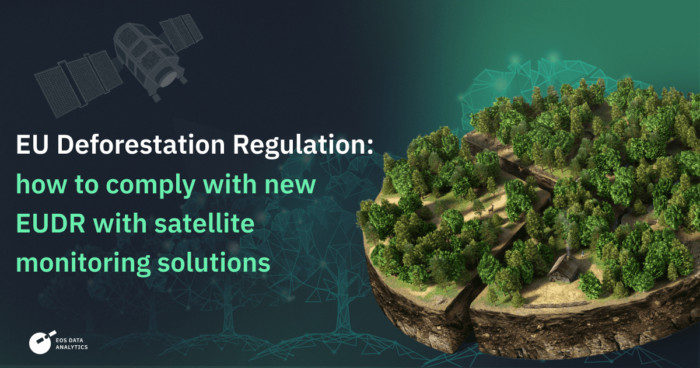How to comply with new EUDR with satellite monitoring solutions

Navigating EUDR Compliance with satellite imagery: Insights from EOS Data Analytics
The European Union’s Deforestation-Free Regulation (EUDR) is reshaping commodity trading, targeting deforestation, and enhancing supply chain transparency. Europe’s substantial imports of deforestation-related commodities, encompassing an area larger than the EU itself, prompted the need for this pioneering regulation. To help companies achieve EUDR compliance, EOS Data Analytics offers custom-tailored access to satellite imagery data, as well as innovative solutions, such as a web interface for tracking deforestation and AI-aided forest monitoring.
Understanding EUDR: A Game-Changer in Deforestation-Free Market
EUDR is a comprehensive regulatory framework aimed at combating deforestation, a critical issue that affects global biodiversity, climate stability, and communities dependent on forests. It represents a milestone for the European Union and the world at large.
At its core, EUDR seeks to curb deforestation and preserve global biodiversity. The regulation holds companies within the EU, as well as their suppliers, accountable for sourcing high-risk commodities such as soy, palm oil, and cocoa, which may come from deforested areas. Non-compliance could lead to penalties, restricted market access, or fines scaled to the extent of environmental damage. Violations could result in fines, market access restrictions, or fines proportional to environmental damage.
Impacted Regions and Businesses
The regulation impacts both European companies and international suppliers. As EUDR focuses on specific commodities historically linked to deforestation, it primarily affects regions importing restricted commodities to the EU, such as LATAM, Asia, and Central America. Specifically, companies engaged in the trade of coffee, cocoa, rubber, beef, palm oil, wood, and soybeans will have to comply.
Kostiantyn Chernyshevskyi, Product Manager of EOSDA Forest Monitoring at EOS Data Analytics, adds: “Europe aims to source these commodities from lands that are not deforested. EUDR further denotes that risk levels will be assigned to entire countries, affecting customs checks and potentially scrutinizing higher-risk commodities more rigorously. On top of that, there will be something like a digital supply chain database, in which authorities will be able to trace all companies associated with import activities. Failure to provide necessary reports may result in substantial fines and even limited market access.”
EUDR compliance is expanding across various sectors, including agriculture, forestry, software development, auditing, consultancy, and insurance. Every country worldwide will undergo risk assessment, with reporting frequencies varying based on crop seasonality. For example, if the soybean harvest occurs three times a year, both the producer and the transporter will have to report three times during that period.
Implementing Satellite Tech for EUDR Compliance
To ensure a deforestation-free approach that aligns with European regulations, Kostiantyn Chernyshevskyi recommends collecting satellite data from various sources.
To provide error-free evidence to authorities, it’s beneficial to combine optical and SAR data. EOSDA Forest Monitoring offers access to multiple satellite data sources, providing additional services beyond basic data acquisition. For instance, users can request advanced computer vision AI. Additionally, it is possible to use high-resolution satellite imagery, including from specialized sources like the EOS SAT-1 satellite, built specifically for EOS Data Analytics and optimized for precise forest and agricultural land monitoring.
The EOSDA Forest Monitoring platform streamlines EUDR reporting and includes services like deforestation and reforestation monitoring, tree species detection, biomass estimation, and forest fire monitoring.
How to make sure that a company provides reliable deforestation-free evidence for a sufficient EUDR report? Kostiantyn Chernyshevskyi underscores the importance of transparency and traceability.
Companies must provide georeferenced and time-stamped evidence proving that their products were not sourced from deforested land. Suppliers must submit due diligence statements to demonstrate compliance, and authorities will share this information with the European Commission to ensure traceability. It’s advisable to use satellite imagery that has undergone essential processing, such as atmospheric correction, and to make sure that the resulting data accurately indicates the situation.
Kostiantyn Chernyshevskyi highlights: “Various imagery acquisition strategies, including on-site inspections and satellite observations, are suitable for performing successful EUDR compliance. Satellite technology offers a cost-effective and sustainable method for evidence collection.”
EOSDA Forest Monitoring provides custom solutions tailored to individual client needs. Reports generated on demand can include both vector and raster maps, while data can also be accessed via API interfaces for seamless integration.
EUDR will come into effect at the end of 2024. Not surprisingly, clients of EOS Data Analytics are already exploring satellite-based software solutions for their supply chain management. Producers of EUDR-regulated commodities, such as beef, soy, cocoa, coffee, palm oil, and rubber, are especially active. Satellite technologies, including those offered by EOS Data Analytics, empower businesses to navigate EUDR compliance effectively.


